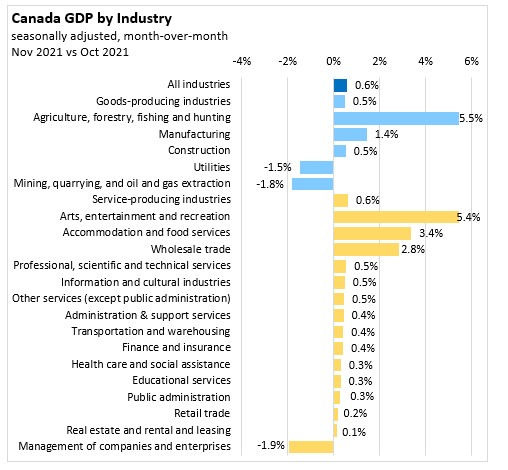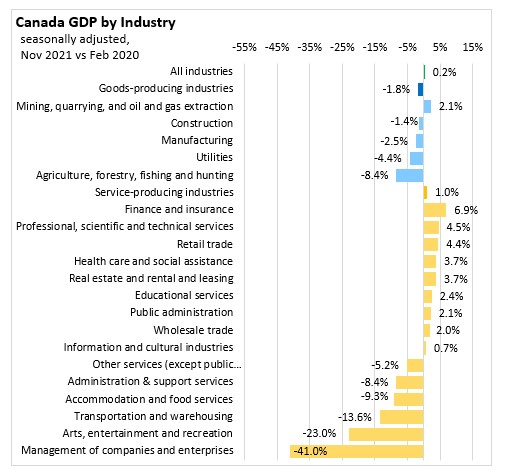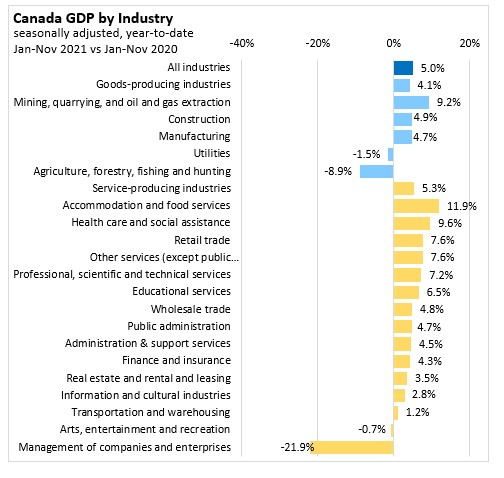The Economics and Statistics Division maintains archives of previous publications for accountability purposes, but makes no updates to keep these documents current with the latest data revisions from Statistics Canada. As a result, information in older documents may not be accurate. Please exercise caution when referring to older documents. For the latest information and historical data, please contact the individual listed to the right.
<--- Return to Archive
For additional information relating to this article, please contact:
February 01, 2022CANADA GDP BY INDUSTRY, NOVEMBER 2021 With November reference month results, year-over-year (November 2021 vs November 2020) and year-to-date (Jan-Nov 21 vs Jan-Nov 20) are showing the rebounds in economic activity from the unprecedented declines observed at the start of the COVID-19 pandemic.
Real Gross Domestic Product (GDP) in Canada increased 0.6% in November 2021. In November, activity was up in 17 of 20 industrial sectors compared to the previous month, with gains in services producing (+0.6%) and goods-producing industries (+0.5%).
The Canadian economy was 0.2% bigger when compared to pre-pandemic February 2020 with an annualized value of $2,015 billion (chained 2012 dollars) in November 2021.
Statistics Canada’s preliminary estimate for real GDP shows no change in December. Gains in manufacturing, agriculture, forestry, fishing and hunting, utilities and wholesale trade sectors were offset by declines in the accommodation and food services, mining, quarrying, and oil and gas extraction and retail trade sectors. This advance estimate for December indicates a 1.6% increase in the fourth quarter of 2021, and a 4.9% increase for 2021. The official GDP data for December 2021 will be published on March 1, 2022.


Goods-Producing Industries
Goods-producing sector output grew 0.5% month-over-month in November 2021.
Manufacturing activity increased 1.4% in November, led by broad-based growth both in durable and non-durable goods. Durable-goods manufacturing was up 1.8% with higher activity in transportation equipment manufacturing (+3.6%). Non-durable goods manufacturing activity increased 1.0% driven by a 6.8% gain in petroleum and coal products.
Construction was up 0.5% as all sub-sectors saw increased activity in November. Engineering and other construction activities increased 1.0% in November, posting the largest monthly gain since April. Residential building construction increased 0.2% as gains in home alterations and improvements more than offset declines in all forms of new residential dwellings construction. Non-residential building construction was up 0.5% which was the fifth consecutive monthly gain.
Mining, quarrying, and oil and gas extraction declined 1.8% in November. This was the first month-over-month decline in seven months as all subsectors contracted. After reaching the pre-pandemic level of production in October, oil and gas extraction decreased 2.5% in November. Coal mining was down 17.2% due to exports disruptions caused by flooding in British Columbia. Support activities for mining, and oil and gas extraction were down 2.0% in November, after six consecutive months of growth, with drilling services contributing the most to the decline.
Agriculture, forestry, hunting and fishing was up 5.5% in November on higher GDP from crop production activities.
Services-Producing Industries
Output of the services-producing sector increased 0.6% in November 2021.
Arts, entertainment and recreation sector increased 5.4% in November with growth across all subsectors. Easing of capacity limits on large group and indoor gatherings supported increased activity. Performing arts, sports and heritage institutions (+9.2%) led the growth driven by higher attendance at two CONCACAF World Cup 2022 qualifying soccer games played in Edmonton.
Accommodation and food services sectors increased 3.4% in November after two consecutive months of decline. November's gain was supported by increased activity both in accommodation (+7.1%) and food services and drinking places (+2.0%).
Real estate and rental and leasing increased 0.1% in November. Declines in activity at the offices of real estate agents and brokers (-0.8%) and lessors of non-financial intangible assets (-1.7%) were more than offset by increases in other industries comprising the sector.
Retail trade was up 0.2% with 6 of 12 subsectors posting gains, led by gasoline stations (+3.8%), clothing and clothing accessories stores (+2.5%) and building material and garden equipment and supplies dealers (+2.6%). Sporting goods, hobby, book and music stores (-8.6%) and electronic and appliance stores (-4.8%) posted the largest declines.
Professional, scientific and technical services sector was up 0.5%, posting the seventh consecutive monthly gain.

November 2021 vs February 2020
Canadian real GDP was 0.2% higher when compared to February 2020.
Amid the COVID-19 pandemic and recovery to date, the service sectors with the current largest declines in activity are in management of companies and enterprises (-41.0%), arts, entertainment and recreation (-23.0%), transportation and warehousing (-13.6%) and accommodation and food services (-9.3%). For November 2021, all goods-producing industries were at lower levels of activity than February 2020 except mining, quarrying, and oil and gas extraction. Activity has increased in some private service sectors compared to February 2020: finance and insurance (+6.9%), retail trade (+4.4%), professional, scientific and technical services (+4.5%), health care and social assistance (+3.7%) and real estate and rental and leasing (+3.7%). Public administration GDP has increased 2.1% from February 2020.

Year-to-Date (Jan-Nov 2021 vs Jan-Nov 2020)
The Canadian economy in the first eleven months of 2021 increased 5.0% compared to the same period in 2020.
Compared to the same period last year, the largest increases in activity have been in accommodation and food services (+11.9%), health care and social assistance (+9.6%), mining, quarrying, and oil and gas extraction (+9.2%), and retail trade (+7.6%). Activity decreased the most in management of companies (-21.9%) and agriculture, forestry, fishing and hunting (-8.9%).

Source: Statistics Canada, Table 36-10-0434-01 Gross domestic product (GDP) at basic prices, by industry, monthly (x 1,000,000)
<--- Return to Archive